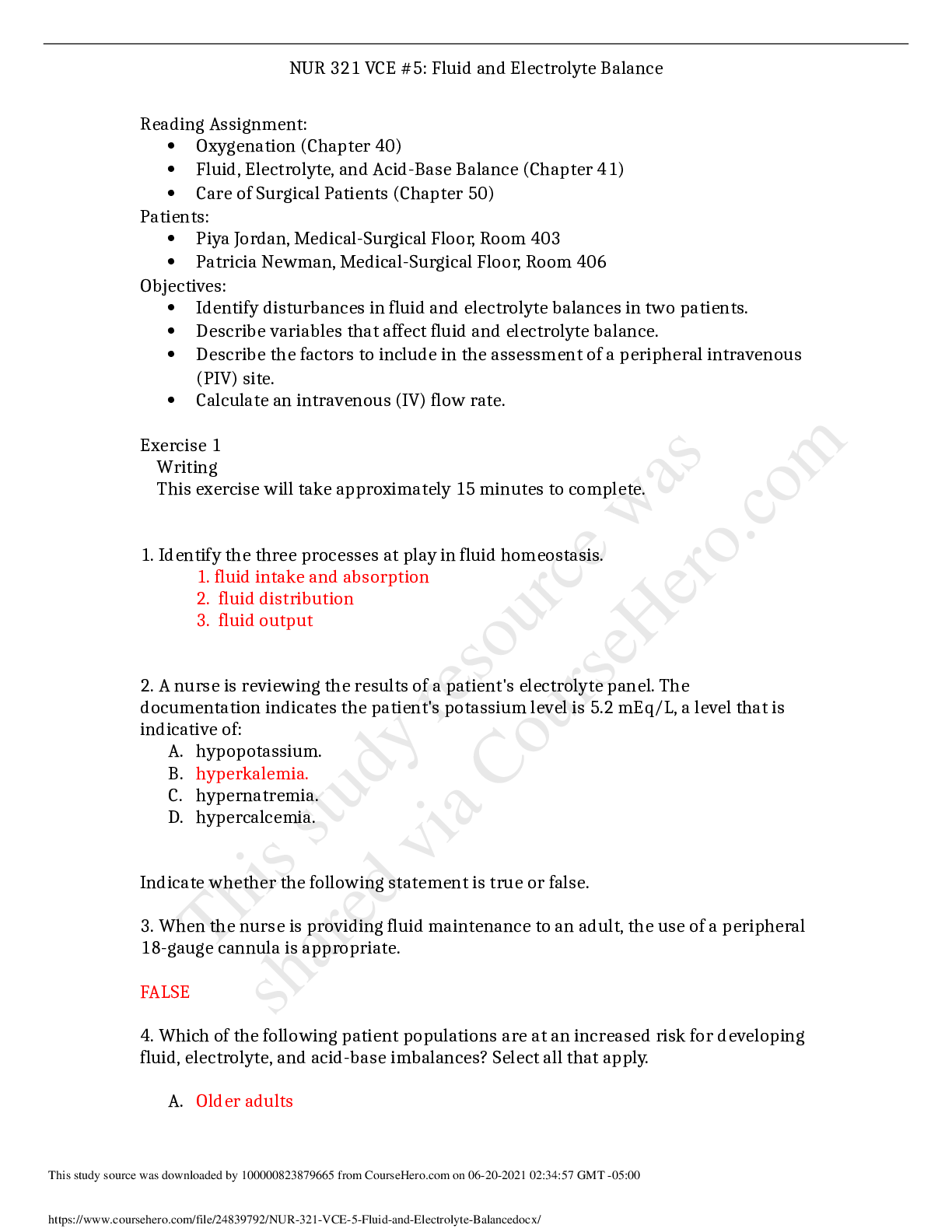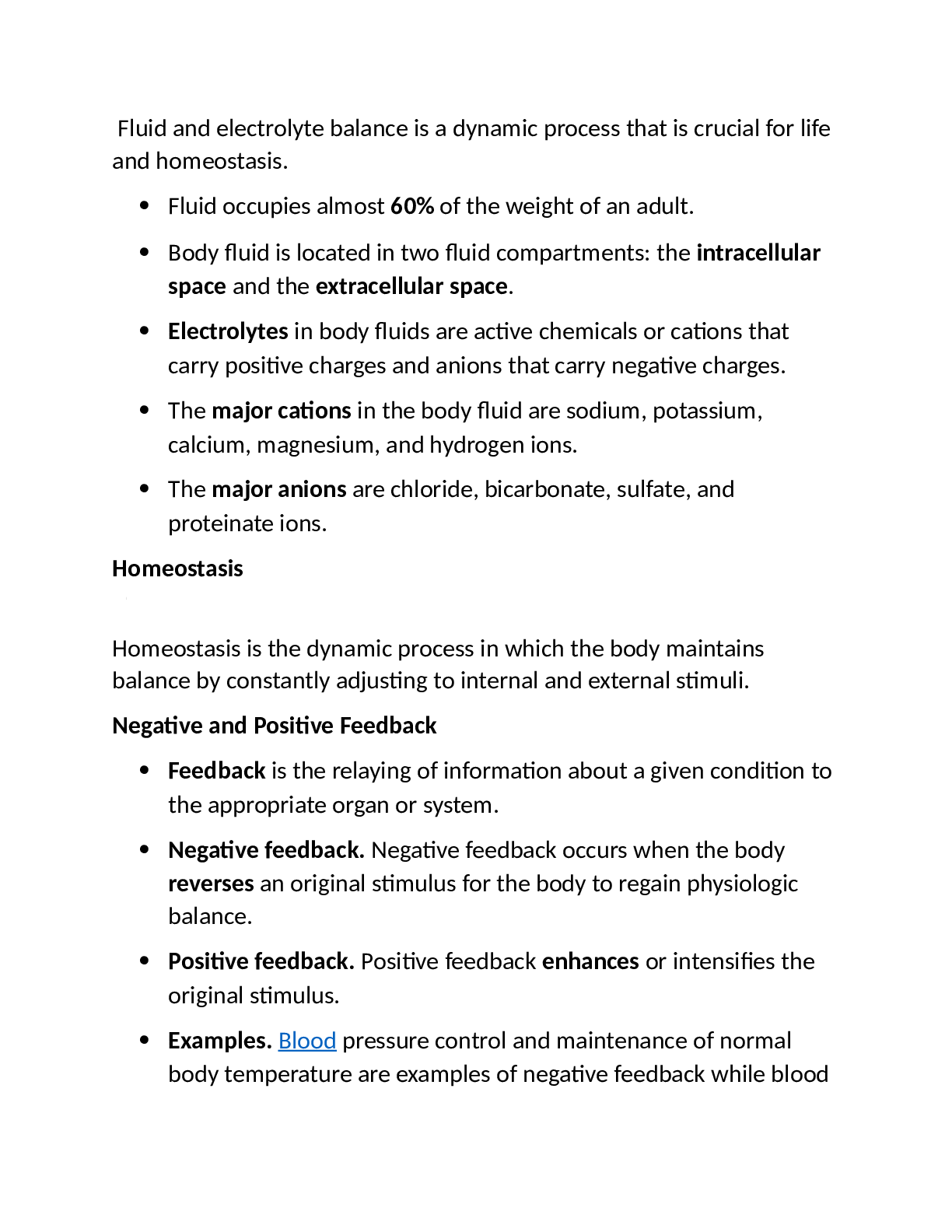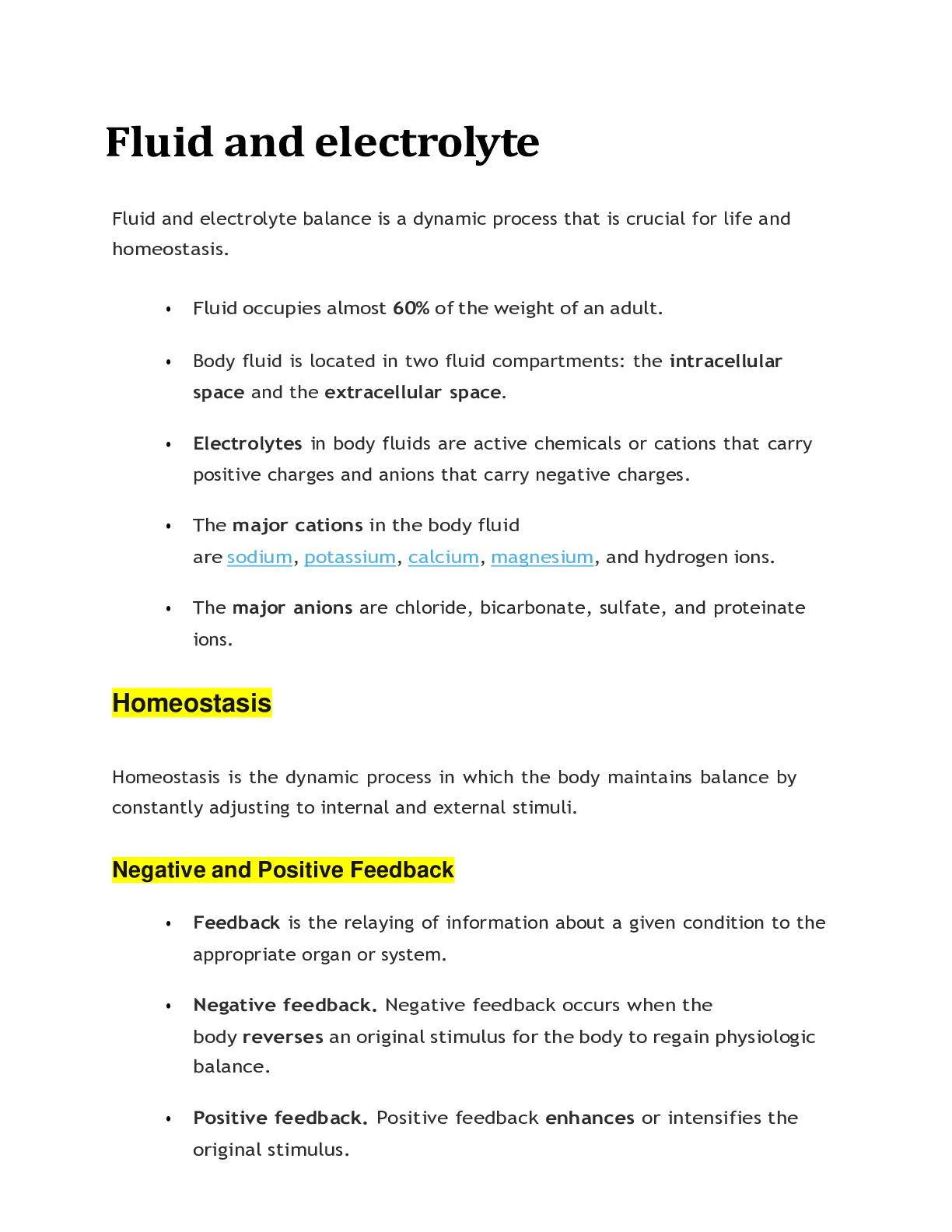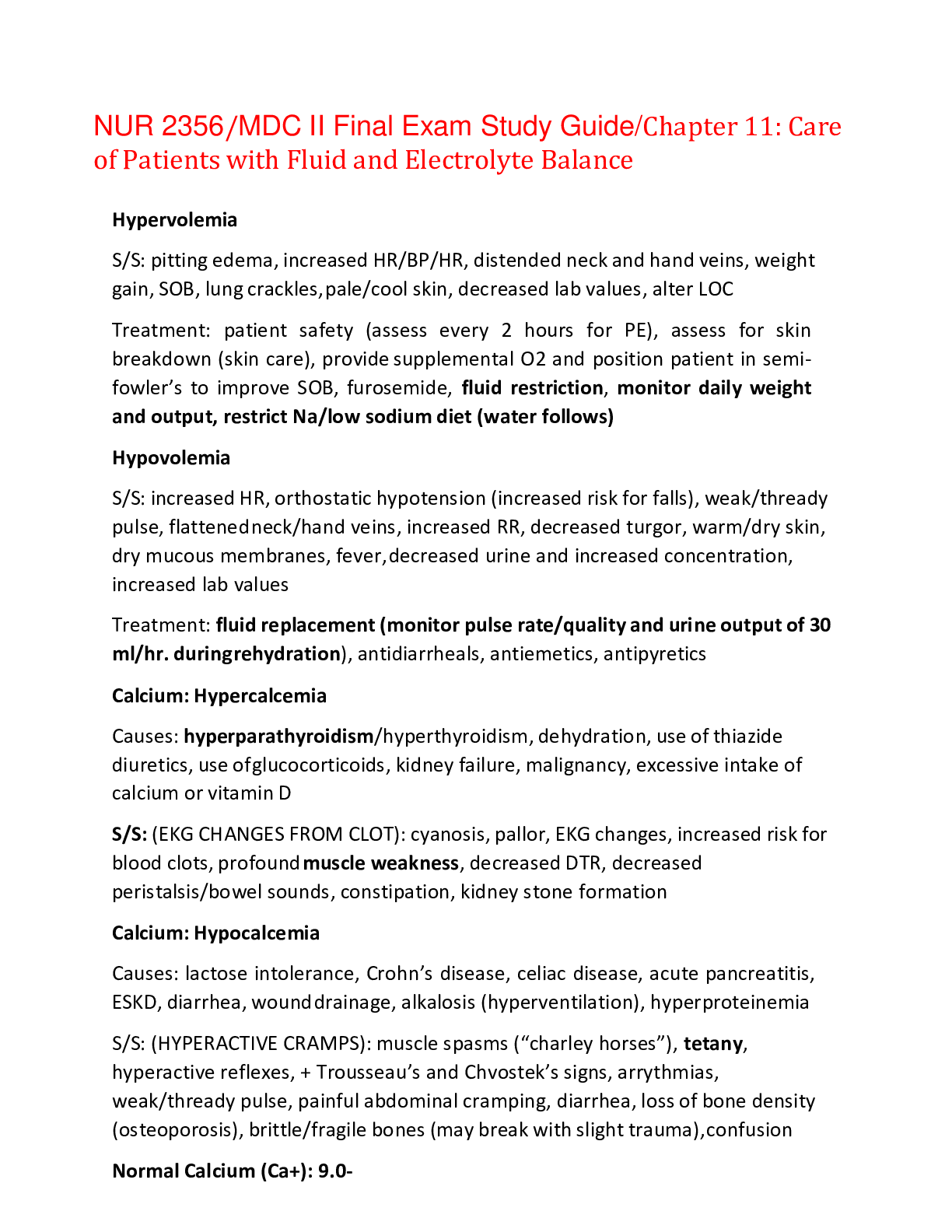*NURSING > STUDY GUIDE > Tyler Graves, Fluid and Electrolyte Imbalance Athlete, Learner (All)
Tyler Graves, Fluid and Electrolyte Imbalance Athlete, Learner
Document Content and Description Below
Patient History Past Medical History: He had tubes placed in ears when he was 3-years-old. He had a sports physical prior to beginning practices and was cleared to play. His immunizations are up to ... date Allergies: None Medications: None Code Status: Full Code Social/Family History: Patient lives at home with his parents and two siblings. He is an A student and star player for his football team. He says he doesn’t want to disappoint his coach or the team and wants to return to practice later this afternoon after discharge. He denies smoking and drinking alcohol. Handoff Report Situation: The patient is a 16-year-old male who was admitted to the Emergency Department (ED) for dehydration and electrolyte imbalance caused by heat exhaustion. He passed out this afternoon during football practice and was brought to the ED by his football coach. His mother has been notified, and she is on her way. Background: The patient is brought to the ED on a hot and humid August afternoon by his football coach, who states the patient passed out during afternoon practice. While the team has been practicing about a week, today is the first day of the team’s two-a-day practices. The patient is the star athlete of his high school football team. Upon questioning, the patient states he did have some muscle cramps this morning after practice, but they went away after he drank fluids and rested at lunch. He is not thirsty and does not need to urinate. When the patient is asked when he voided last, he states he voided before the morning practice. His coach states he has no known health problems. Tyler Graves Age: 16 Weight: 55 kg Location: Emergency Department (ED) Basic Assessment of the Athlete with Fluid and Electrolyte Imbalance PNCI® - Learner 2 Program for Nursing Curriculum Integration (PNCI®) © 2012 CAE Healthcare, Sarasota, FL v.5 Handoff Report Continued Assessment: Vital signs: HR 96, BP 118/76, RR 32, SpO2 96% on room air, Temperature 38.9C General appearance: Diaphoretic and still in his football uniform. Mildly distressed, with shallow respirations Cardiovascular: Sinus tachycardia. Capillary refill less than three seconds. Pulse weak and thready and 1+ Respiratory: Breath sounds with rhonchi bilaterally GI: Hypoactive bowel sounds. Complains of nausea GU: Has not voided since before morning practice and does not need to urinate Extremities: Moves all extremities with generalized weakness Skin: Pale, cool and clammy. Skin turgor poor and tongue dry Neurological: Lethargic but alert enough to answer questions. Complains of lightheadedness and has slightly slurred speech. Although he doesn’t carry on a conversation, he is alert enough to answer questions. Pupils dilated and equal IVs: Saline lock in right forearm started by the triage nurse Labs: Admission labs drawn. Results pending Fall Risk: High risk for falls Pain: Complains of headache Recommendations: Implement admission orders and monitor for instability Orders Initial Healthcare Provider’s Orders: Admit to Emergency Department Diagnosis: Heat Exhaustion Full Code Oral fluids as tolerated Vital signs with orthostatic blood pressures Administer 500 mL 0.9% normal saline bolus Notify of urine output of less than 30 mL/hour after fluid bolus CBC and electrolytes, BUN, creatinine, glucose STAT Basic Assessment of the Athlete with Fluid and Electrolyte Imbalance PNCI® - Learner 3 Program for Nursing Curriculum Integration (PNCI®) © 2012 CAE Healthcare, Sarasota, FL v.5 Preparation Learning Objectives • Performs an accurate basic physical assessment of the patient with fluid and electrolyte imbalance (APPLYING) • Identifies normal and abnormal assessment findings (UNDERSTANDING) • Documents normal and abnormal assessment findings in relation to fluid and electrolyte imbalance (APPLYING) • Demonstrates strategies for treating dehydration related to heat exhaustion (APPLYING) • Identifies teaching opportunities regarding heat-related illnesses (UNDERSTANDING) Recommended eDose modules for learners to complete before the SCE: Medication Dosage Calculation Skills Medication Orders & S. I. Units Tablets & Capsules Liquid Medicines Injections X I.V. Infusions Injectable Medicines Therapy Slow I.V. Injections X Intermittent Infusions Continuous Infusions Pediatrics This SCE addresses the following QSEN Competencies: X Patient-Centered Care X Teamwork and Collaboration X Evidence-Based Practice Quality Improvement X Safety Informatics Preparation Questions • What factors predispose a person to exertional heat illness (EHI)? • Describe the pathophysiology of dehydration. • Which types of dehydration are most often associated with heat-related illnesses? • What electrolyte findings are common with these types of dehydration? • What assessment findings are consistent with dehydration? • Describe the differences between heat cramps, heat exhaustion and heat stroke. • How do symptoms and treatments differ for these three heat-related illnesses? • What are the signs of rehydration? • Discuss health promotion strategies to prevent EHI. Basic Assessment of the Athlete with Fluid and Electrolyte Imbalance PNCI® - Learner 4 Program for Nursing Curriculum Integration (PNCI®) © 2012 CAE Healthcare, Sarasota, FL v.5 References Ackley, B.J., & Ladwig, G. B. (2010). Nursing diagnosis handbook: An evidence-based guide to planning care (9th ed.). St. Louis, MO: Elsevier Mosby. Ainsworth, S. (2009). Staying healthy if the heat rises. Practice Nurse. 38(3), 43-44. Armstrong, L. E., & Lopez, R. M. (2007). Return to exercise training after heat exhaustion. Journal of Sport Rehabilitation, 2007, 16(3), 162-189. Black, J. M., & Hawks, J. H. (2009). Medical-surgical nursing: Clinical management for positive outcomes (8th ed) St. Louis, MO: Saunders. Bray, P. Sokas, R., & Ahluwalla, J. (2010). Heat-related illnesses: Opportunities for prevention. Journal of Occupational and Environmental Medicine/American College of Occupational and Environmental Medicine. 52(8), 844-845. doi:10.1097/JOM.0b013e3181ed4c36 Cleary, M. (2007). Predisposing risk factors on susceptibility to exertional heat illness: Clinical decisionmaking considerations. Journal of Sport Rehabilitation, 16(3), 204-214. Coris, E.E., Walz, S., Konin, J., & Pescasio, M. (2007). Return to ac [Show More]
Last updated: 1 year ago
Preview 1 out of 5 pages
Instant download
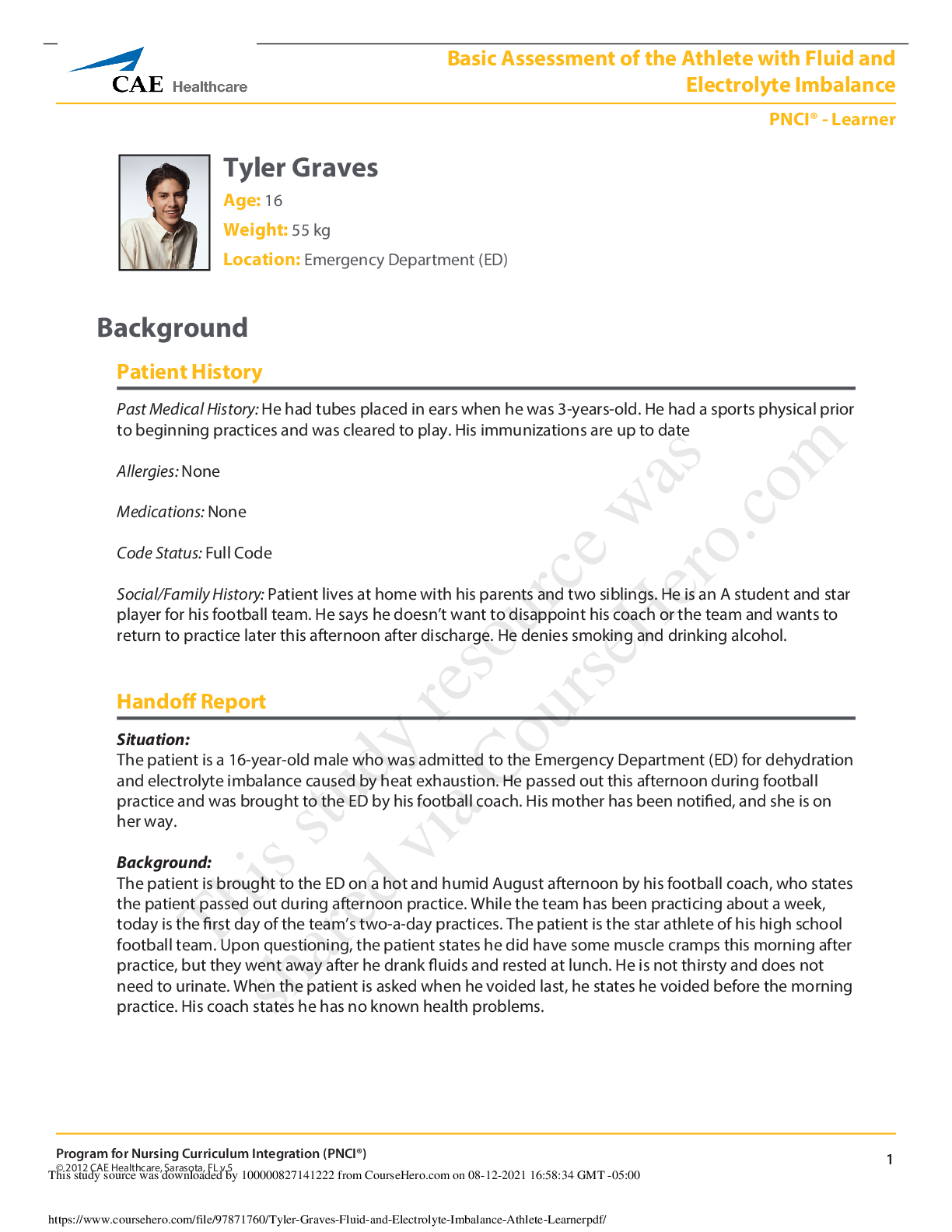
Buy this document to get the full access instantly
Instant Download Access after purchase
Add to cartInstant download
Reviews( 0 )
Document information
Connected school, study & course
About the document
Uploaded On
Aug 13, 2021
Number of pages
5
Written in
Additional information
This document has been written for:
Uploaded
Aug 13, 2021
Downloads
0
Views
36

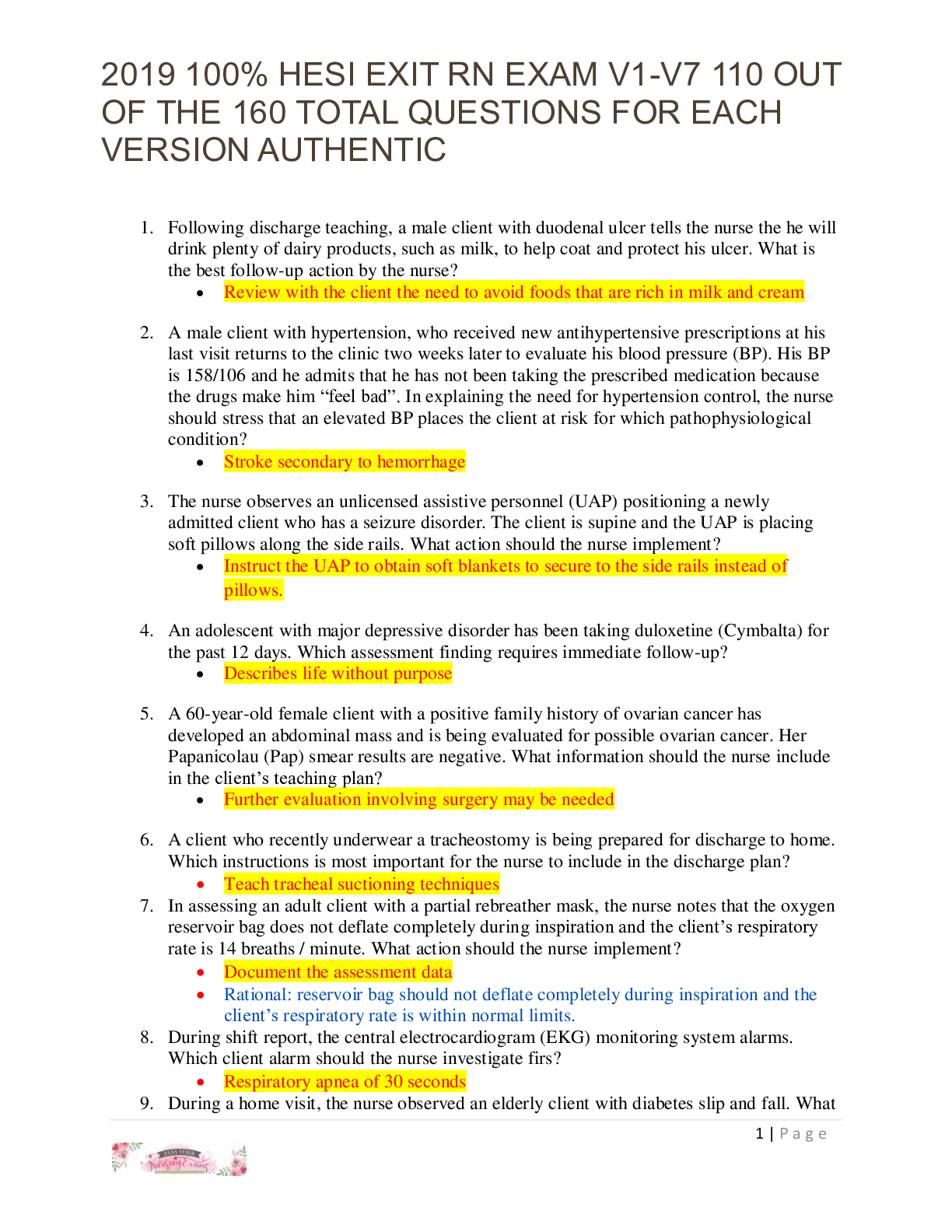

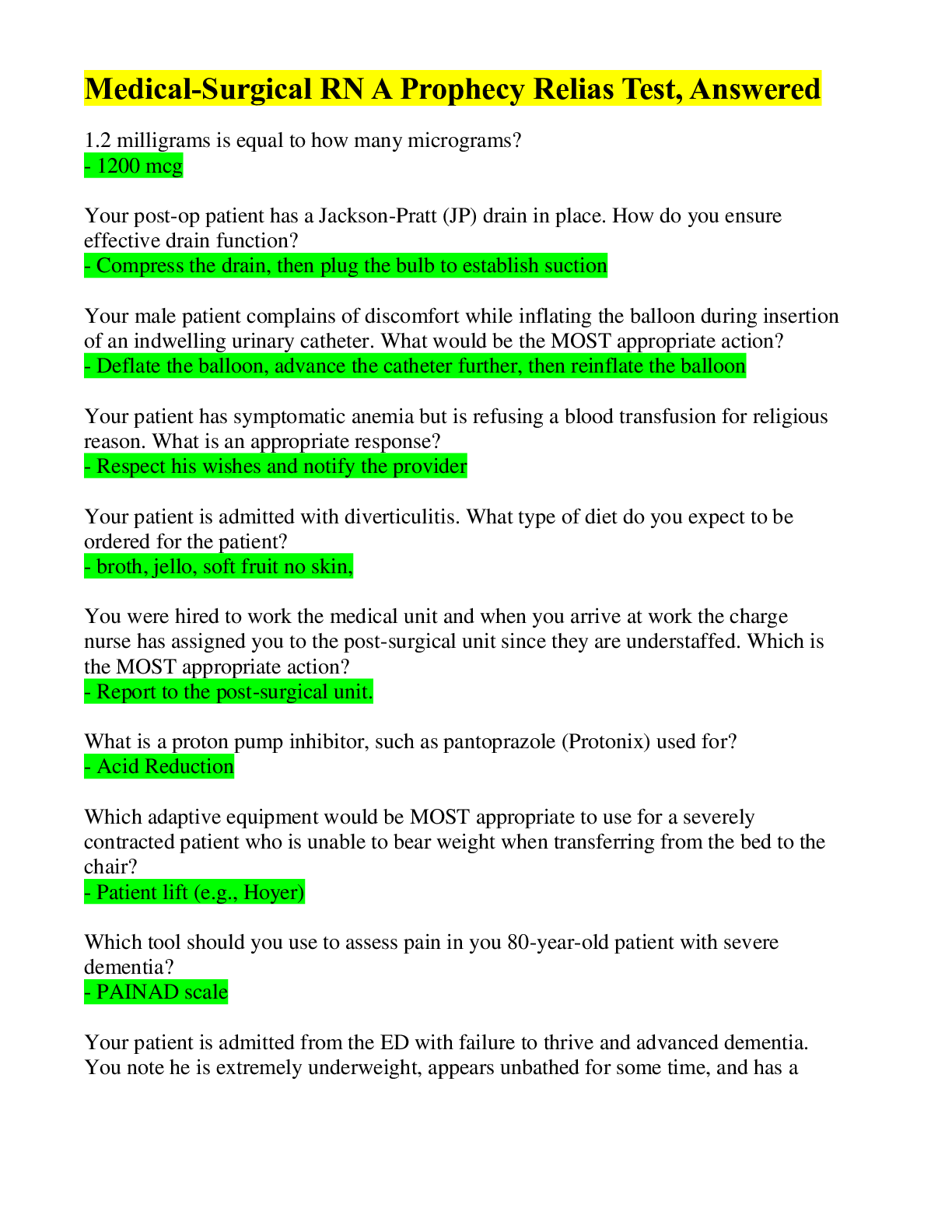

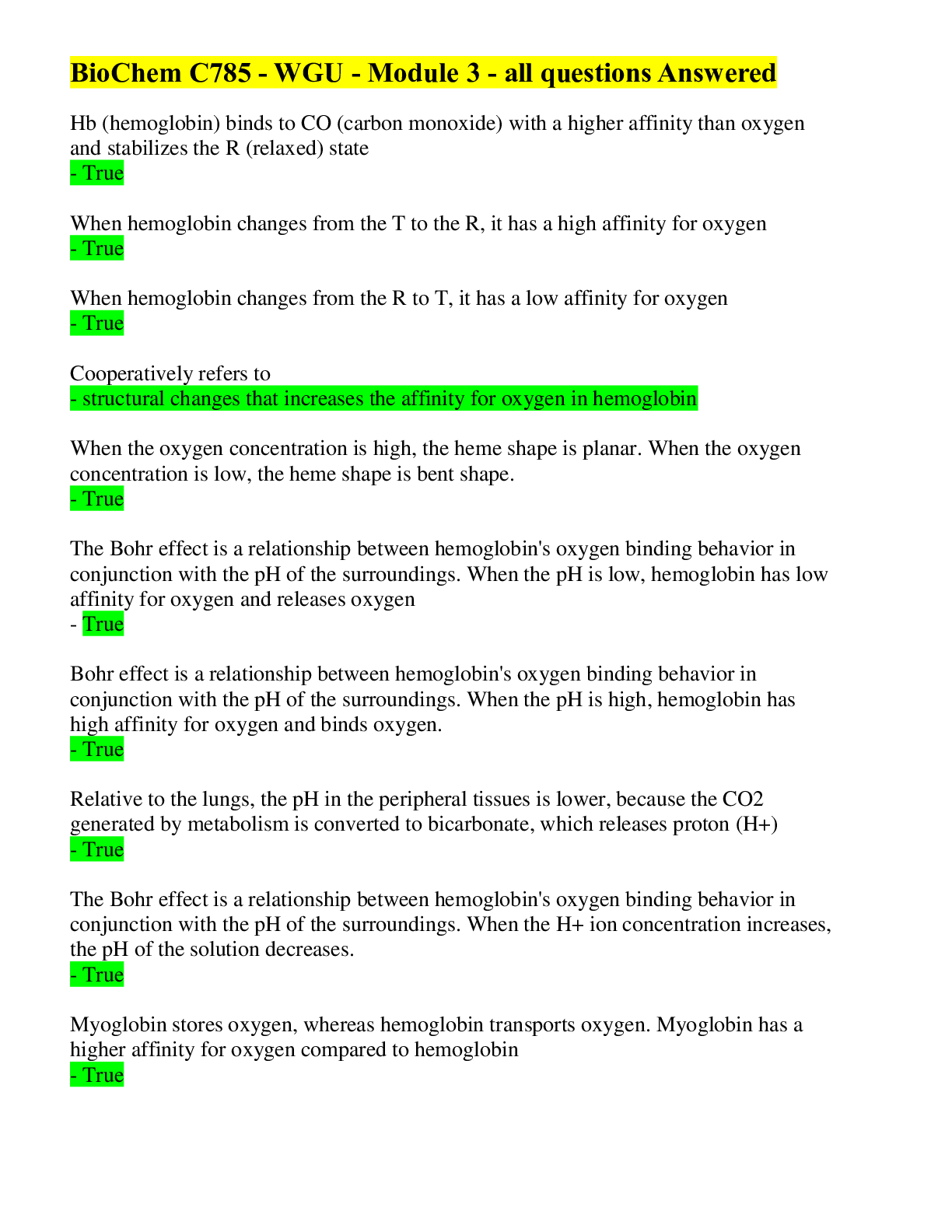


.png)
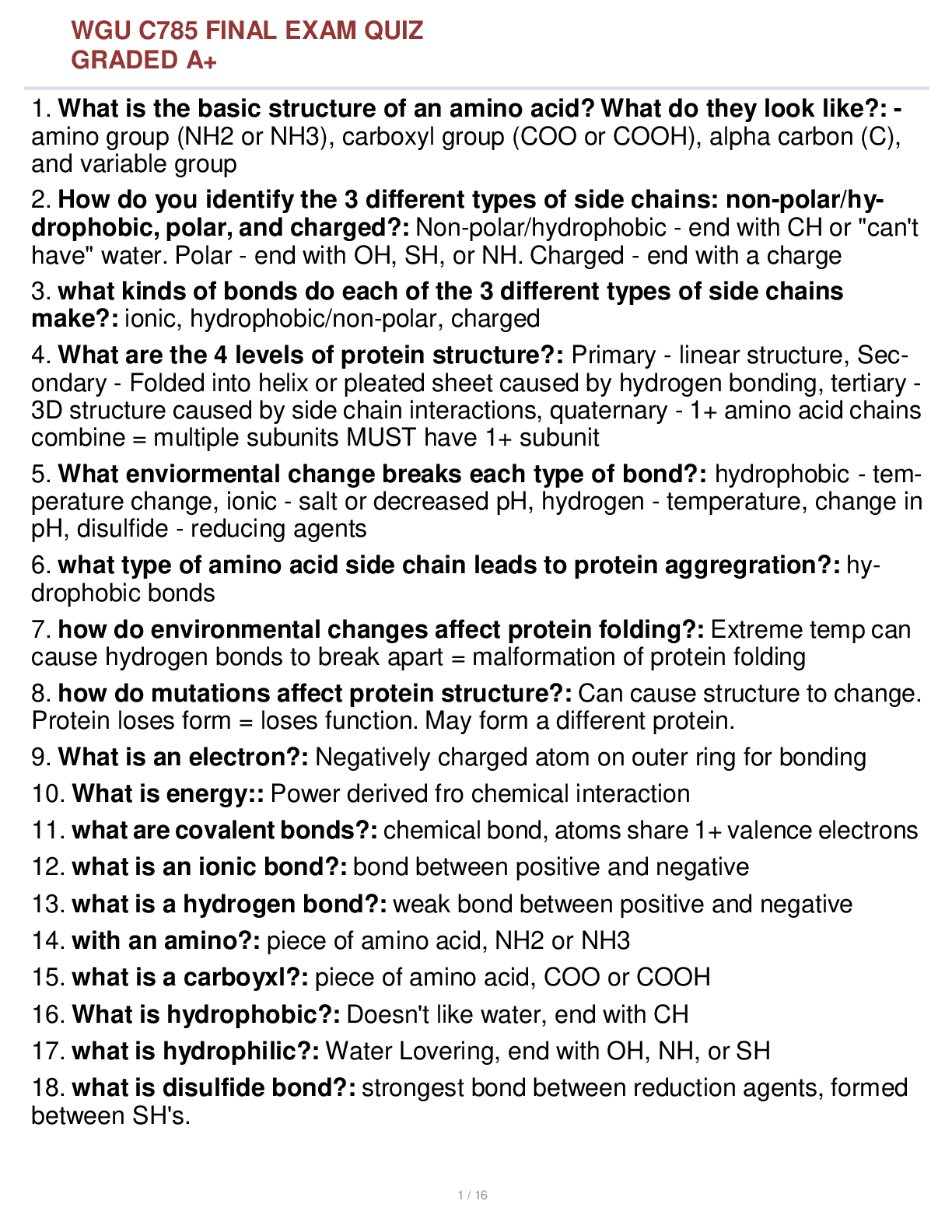
.png)
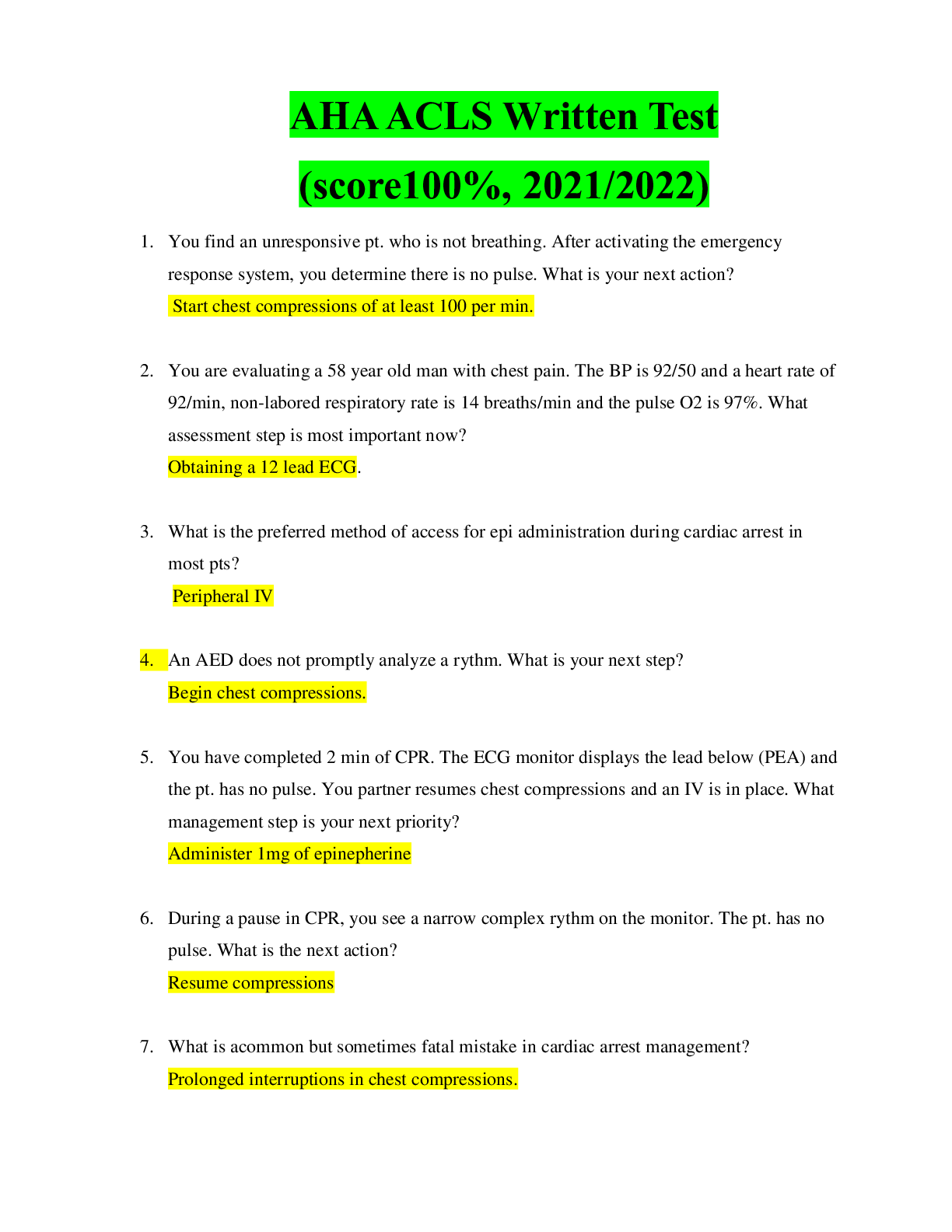
.png)
 Correct Study Guide, Download to Score A.png)
